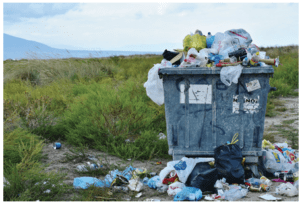“Scientific literature highlights the lack of political will, public education, funding, and corruption as some of the key challenges in environmental safeguarding. While objective policy tools can resolve these challenges, ethical dilemmas in environmental protection strategies are often overlooked”.
By Fr Corbinian Kyara, SJ
Pollution, climate change, habitat destruction, and over-exploitation of natural resources are harming people’s health and well-being, especially in poor regions. The United Nations’ Sustainable Development Goals (SDGs) partly respond to this reality by focusing on three aspects of sus stainable development: social inclusion, economic growth, and environ mental safeguarding. The current reflection seeks to understand the significance and challenges of environmental safeguarding, identify ethical dilemmas sur rounding environmental safeguarding and then show ways in which technological advancement, environ mental education, and religion might support ongoing global environmental safeguarding initiatives. Environmental safeguarding is a process of implementing a set of strategies to prevent or lessen the harmful effects that human activity has on the ecosystem. These include environmental education, enacting and enforcing rules and regulations that support e.g., sustainable resource management, preventing and reducing pollution, using pesticides, and emitting greenhouse gases, safeguarding our cultural heritage and special natural assets, etc.

Why is it important to safeguard the environment?
The justifications for environmental safeguarding stem from the fact that some human actions have significant negative effects on the environment, so safeguarding it and preventing these effects is necessary. Some of the most widely accepted safeguarding justifications include the following. First, safeguarding the environment is essential to guaranteeing the existence of living things and the preservation of the natural world. Nature is essential to the life of living things – hu mans, plants, animals, etc. To survive, all living things depend on a balanced ecosystem. For example, maintaining the balance of the Earth’s food cycles and preventing pollution – such as controlling greenhouse gas emissions – are all made possible by the integrity of the ecosystem. Second, environmental safeguarding is required to alleviate the negative effects of human activities on the environment and to promote healthy living conditions and the natural world. For example, mitigating the environmental impact of industries and reducing harmful industrial emissions require consistent safeguarding. Thus, consistent safeguarding is necessary for regulating the social and environmental externalities that come with eco nomic operations. Third, environmental safeguarding is necessary for the prevention of material waste and for the promotion of a sustainable lifestyle. Safeguarding strategies such as reusing and re cycling practices lessen reliance on natural resources and help to maintain a healthy planet by lowering the need to extract more resources – e.g., water, minerals, and wood – for new products. Finding uses for extra, surplus, or thrown-away things helps reduce waste. For instance, recycling and reusing in a construction project includes figuring out how to keep materials out of landfills, planning and designing to reduce waste, buying resources strategically, and giving or sending surplus materials to recycling facilities.
Ethical dilemmas associated with environmental safeguarding.
Scientific literature highlights the lack of political will, public education, funding, and corruption as some of the key challenges in environmental safeguarding. While objective policy tools can resolve these challenges, ethical dilemmas in environmental protection strategies are often over looked, creating a knowledge vacuum, and highlighting the need for more comprehensive understanding and examination. An ethical dilemma arises when there are two or more possibilities, yet neither of them is the most morally or ethically right. In this sub section, we bring to light three ethical dilemmas associated with environ mental safeguarding. First, an ethical dilemma arises when safeguarding the environment requires limiting people’s primary source of income. Environmental safeguarding may involve balancing ecosystem health with preserving traditional income sources. Often, decision-makers must decide whether to prioritize traditional means of subsistence over a healthy environment, which could negatively impact the livelihood of the poor. Yet, short-term benefits are short lived and long-term environmental degradation undermines financial gains and negatively impacts the host community. For instance, while the Ogiek indigenous people in Kenya are resisting forced evictions from their ancestral Mau Forest, suing the government for human rights breaches, the government on the other side is seeking to protect the forest from encroachment and devastation by individuals who unaccountably cut trees for firewood and charcoal. The scenario highlights the inherent conflict between environmental safeguarding and traditional subsistence practices, with neither side exhibiting the most moral or ethical right. The second ethical dilemma is in terms of environmental taxes, commonly called green taxes. The environmental taxes are taxes largely on pollution and fossil products e.g., electricity, diesel, natural gas, and coal. Some countries have adopted green taxes. e.g., the EU has set ambitious goals to combat climate change and promote a cleaner environment through the European Green Deal, aiming to become climate-neutral by 2050 and reduce greenhouse gas emissions by 55% by 2030. However, the question remains whether green taxes will lead to a more sustainable future. Taxing fossil fuel products and polluting industries does not necessarily stop environ mental degradation because producers of such essential goods pass on increased costs to consumers, thereby putting a greater burden on final consumers. The burden of green taxes therefore falls disproportionately on the poor, while the industries that pollute continue to enjoy considerable tax forwarding; this is a highly dubious ethical scenario. The third moral dilemma in environmental safeguarding has to do with the level of acceptable risk and harm. The determination of harmful contaminants and safety levels is a technical issue. Likewise, the decision on the levels of acceptable pollution should be made by those affected by the quality of their surroundings. People should make political decisions on the natural environment because it is a common good. However, often people are not provided with information about the actual trade-offs society is making. In practice, the government is typically responsible for determining acceptable pollution levels and creating laws to penalize violators; the public rarely votes for alternatives or receives information about the trade-offs. I note that even though the topic is technical and best left to technicians, any choice of levels includes value judgment, and there is no reason to believe that technicians represent or even share the same values as most of society.
Environmental safeguarding may involve balancing ecosystem health with preserving traditional income sources. Often, decision-makers must decide whether to prioritize traditional means of subsistence over a healthy environment, which could negatively impact the livelihood of the poor. Yet, short-term benefits are short lived and long-term environmental degradation undermines financial gains and negatively impacts the host community. For instance, while the Ogiek indigenous people in Kenya are resisting forced evictions from their ancestral Mau Forest, suing the government for human rights breaches, the government on the other side is seeking to protect the forest from encroachment and devastation by individuals who unaccountably cut trees for firewood and charcoal. The scenario highlights the inherent conflict between environmental safeguarding and traditional subsistence practices, with neither side exhibiting the most moral or ethical right. The second ethical dilemma is in terms of environmental taxes, commonly called green taxes. The environmental taxes are taxes largely on pollution and fossil products e.g., electricity, diesel, natural gas, and coal. Some countries have adopted green taxes. e.g., the EU has set ambitious goals to combat climate change and promote a cleaner environment through the European Green Deal, aiming to become climate-neutral by 2050 and reduce greenhouse gas emissions by 55% by 2030. However, the question remains whether green taxes will lead to a more sustainable future. Taxing fossil fuel products and polluting industries does not necessarily stop environ mental degradation because producers of such essential goods pass on increased costs to consumers, thereby putting a greater burden on final consumers. The burden of green taxes therefore falls disproportionately on the poor, while the industries that pollute continue to enjoy considerable tax forwarding; this is a highly dubious ethical scenario. The third moral dilemma in environmental safeguarding has to do with the level of acceptable risk and harm. The determination of harmful contaminants and safety levels is a technical issue. Likewise, the decision on the levels of acceptable pollution should be made by those affected by the quality of their surroundings. People should make political decisions on the natural environment because it is a common good. However, often people are not provided with information about the actual trade-offs society is making. In practice, the government is typically responsible for determining acceptable pollution levels and creating laws to penalize violators; the public rarely votes for alternatives or receives information about the trade-offs. I note that even though the topic is technical and best left to technicians, any choice of levels includes value judgment, and there is no reason to believe that technicians represent or even share the same values as most of society.
Technology, environmental education, and the Church’s social teachings
It is apparent that there is no clear-cut solution for the listed dilemmas; the solution involves a multi-pronged approach. Thus, we conclude our reflection by highlighting the contribution of digital technology, environmental education, and the Church’s social teachings to environmental safeguarding. Digital technologies have the potential to improve industrial operations, increase environmental sustainability, and monitor the environment both nationally and globally. E.g., smart cities, sustainable urbanization and consumption, renewable energy, and sustainable technology solutions are all made possible by digital technologies. Consequently, to fully realize the potential of digital technologies, it is critical to solve the issues raised by the digital economy, including the rise in e-waste, excessive energy use, the digital divide, and data protection. Additionally, through digital technology, public-private partnerships and collaboration will help to generate and use data that will aid the development of better environmental policies and increase resilience to climate change. The significance of environmental education lies in its ability to increase public awareness of environmental issues, motivate behavior change, and foster the development of conscientious citizens capable of reducing environmental harm. Environmental education is essential to preserving the natural cycle of life, conserving natural resources, and assisting communities in expanding their actions within the framework of environmental safeguarding practices and better understanding their cultural conceptions. Sustainable development and the reduction of environmental deterioration are made possible by environmental education, which fosters new environmental attitudes and practices. Religion can have a big and good impact on individuals’ environmental behavior and assist believers in incorporating environmental concerns into their faith. One theological component that has great potential to promote pro environmental sentiments is stewardship belief, which holds that people must care for the earth that God created and entrusted to humanity. The Psalmist maintains that God owns the entire world; “the earth and everything in it, the world and all who live in it” (Psalms 24:1). Further, the Catholic Social Teachings state that climate change is a serious moral issue that endangers our commitments. The teachings call on everyone to defend hu man life, health, dignity, and security; to give the poor preference when making decisions; to advance the common good, which includes preserving the climate; and to live in solidarity with future generations. Therefore, the church’s responsibility in the protection effort extends beyond its doctrinal teachings to include environmental concerns. The world will make more environmental safeguarding progress if religious leaders seize the chance to mandate the fusion of environmental issues with spirituality.
The significance of environmental education lies in its ability to increase public awareness of environmental issues, motivate behavior change, and foster the development of conscientious citizens capable of reducing environmental harm. Environmental education is essential to preserving the natural cycle of life, conserving natural resources, and assisting communities in expanding their actions within the framework of environmental safeguarding practices and better understanding their cultural conceptions. Sustainable development and the reduction of environmental deterioration are made possible by environmental education, which fosters new environmental attitudes and practices. Religion can have a big and good impact on individuals’ environmental behavior and assist believers in incorporating environmental concerns into their faith. One theological component that has great potential to promote pro environmental sentiments is stewardship belief, which holds that people must care for the earth that God created and entrusted to humanity. The Psalmist maintains that God owns the entire world; “the earth and everything in it, the world and all who live in it” (Psalms 24:1). Further, the Catholic Social Teachings state that climate change is a serious moral issue that endangers our commitments. The teachings call on everyone to defend hu man life, health, dignity, and security; to give the poor preference when making decisions; to advance the common good, which includes preserving the climate; and to live in solidarity with future generations. Therefore, the church’s responsibility in the protection effort extends beyond its doctrinal teachings to include environmental concerns. The world will make more environmental safeguarding progress if religious leaders seize the chance to mandate the fusion of environmental issues with spirituality.














